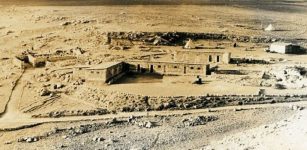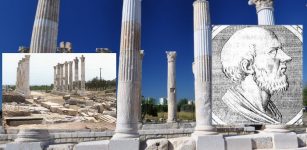Nicolas Bourbaki: The Greatest Mathematician Who Never Was
AncientPages.com - By many measures, Nicolas Bourbaki ranks among the greatest mathematicians of the 20th century.
Largely unknown today, Bourbaki is likely the last mathematician to master nearly all aspects of the field. A consummate collaborator, he made fundamental contributions to important mathematical fields such as set theory and functional analysis. He also revolutionized mathematics by emphasizing rigor in place of conjecture.
There’s just one problem: Nicolas Bourbaki never existed.
Never existed?
While it is now widely accepted that there never was a Nicolas Bourbaki, there is evidence to the contrary.
Bourbaki Congress of 1938. Credit: Public Domain
For example, there are wedding announcements for his daughter Betty, a baptismal certificate in his name and an impressive family lineage extending back to an ancestor Napoleon raised as his own son.
Even the professional mathematics community was misled for a time. When Ralph Boas, an editor of the journal Mathematical Reviews, wrote that Bourbaki was a pseudonym, he was promptly refuted by none other than Bourbaki himself. Bourbaki countered with a letter stating that B.O.A.S. actually just was an acronym of the last names of the editors of the Reviews.
These cases of confused identity were not all fun and games. For example, it is alleged that, while visiting Finland at the outset of World War II, French mathematician André Weil was investigated for spying. The authorities found suspicious papers in his possession: a fake identity, a set of business cards and even invitations from the Russian Academy of Science – all in Bourbaki’s name. Supposedly, Weil was freed only after an officer recognized him as a preeminent mathematician.
Who was Bourbaki?
If Bourbaki never existed, who – or what – was he?
The name Nicolas Bourbaki first appeared in a place rocked by turmoil at a volatile time in history: Paris in 1934.
World War I had wiped out a generation of French intellectuals. As a result, the standard university-level calculus textbook had been written more than two and half decades before and was out of date.
Newly minted professors André Weil and Henri Cartan wanted a rigorous method to teach Stokes’ theorem, a key result of calculus. After realizing that others had similar concerns, Weil organized a meeting. It took place December 10, 1934 at a Parisian café called Capoulade.
The nine mathematicians in attendance agreed to write a textbook “to define for 25 years the syllabus for the certificate in differential and integral calculus by writing, collectively, a treatise on analysis,” which they hoped to complete in just six months.
See also:
Hypatia Of Alexandria – Brilliant, Controversial Scientist And Her Dramatic End
Aristotle’s Influence On Education Of Alexander The Great – Historical Encounter Of Two Famous Men
Catherine Of Alexandria Courageously Confronted 50 Pagan Philosophers And Was Sentenced To Death
As a joke, they named themselves after an old French general who had been duped in the Franco-Prussian war.
As they proceeded, their original goal of elucidating Stokes’ theorem expanded to laying out the foundations of all mathematics. Eventually, they began to hold regular Bourbaki “conferences” three times a year to discuss new chapters for the treatise.
Individual members were encouraged to engage with all aspects of the effort, to ensure that the treatise would be accessible to nonspecialists. According to one of the founders, spectators invariably came away with the impression that they were witnessing “a gathering of madmen.” They could not imagine how people, shouting – “sometimes three or four at the same time” – could ever come up with something “intelligent.”
Top mathematicians from across Europe, intrigued by the group’s work and style, joined to augment the group’s ranks. Over time, the name Bourbaki became a collective pseudonym for dozens of influential mathematicians spanning generations, including Weil, Dieudonne, Schwartz, Borel, Grothendieck and many others.
Since then, the group which has added new members over time, has proved to have a profound impact on mathematics, certainly rivaling any of its individual contributors.
Profound impact
Mathematicians have made a plethora of important contributions under Bourbaki’s name.
To name a few, the group introduced the null set symbol; the ubiquitous terms injective, surjective, bijective; and generalizations of many important theorems, including the Bourbaki-Witt theorem, the Jacobson-Bourbaki theorem and the Bourbaki-Banach-Alaoglu theorem.
The Henri Poincaré Institute, where Bourbaki seminars are regularly held. Antoine Taveneaux/Wikimedia, CC BY-SA
Their text, “Elements of Mathematics,” has swelled to more than 6,000 pages. It provides a “solid foundation for the whole body of modern mathematics,” according to mathematician Barbara Pieronkiewicz.
Bourbaki’s influence is still alive and well. Now in “his” 80th year of research, in 2016 “he” published the 11th volume of the “Elements of Mathematics.” The Bourbaki group, with its ever-changing cast of members, still holds regular seminars at the University of Paris.
Partly thanks to the breadth and significance of “his” mathematical contributions, and also because – ageless, unchanging and operating in multiple places at once – “he” seems to defy the very laws of physics, Bourbaki’s mathematical prowess will likely never be equaled.
Written by David Gunderman - Ph.D. Candidate in Applied Mathematics, University of Colorado Boulder
This article is republished from The Conversation under a Creative Commons license. Read the original article.
More From Ancient Pages
-
 Huge, Cylindrical Pre-Incan Chullpas Of Sillustani, Peru Were Used As Graves For Colla Nobles
Civilizations | Mar 14, 2023
Huge, Cylindrical Pre-Incan Chullpas Of Sillustani, Peru Were Used As Graves For Colla Nobles
Civilizations | Mar 14, 2023 -
 Enigmatic Stones Of The Picts: Orkney’s Unique Stone With Dragon-Like Creature And Cross Carving
Civilizations | Oct 19, 2018
Enigmatic Stones Of The Picts: Orkney’s Unique Stone With Dragon-Like Creature And Cross Carving
Civilizations | Oct 19, 2018 -
 The Assyrian Siege Ramp And Breached Walls At Canaanite City Of Lachish – Studied
Archaeology | Nov 10, 2021
The Assyrian Siege Ramp And Breached Walls At Canaanite City Of Lachish – Studied
Archaeology | Nov 10, 2021 -
 Oldest Door Lock Comes From Ancient Egypt
Ancient History Facts | Jun 27, 2018
Oldest Door Lock Comes From Ancient Egypt
Ancient History Facts | Jun 27, 2018 -
 Mystery Of The Large Ancient Boulders In Ireland And Britain – Possible Connection To The City Of Troy?
Featured Stories | Oct 17, 2023
Mystery Of The Large Ancient Boulders In Ireland And Britain – Possible Connection To The City Of Troy?
Featured Stories | Oct 17, 2023 -
 Sed Festival – Ancient Egyptian Ritual Tested Pharaohs
Ancient History Facts | Mar 28, 2018
Sed Festival – Ancient Egyptian Ritual Tested Pharaohs
Ancient History Facts | Mar 28, 2018 -
 Large Fresco Depicting The Procession Of The Wine God Dionysus Found In Pompeii
Archaeology | Feb 28, 2025
Large Fresco Depicting The Procession Of The Wine God Dionysus Found In Pompeii
Archaeology | Feb 28, 2025 -
 On This Day In History: Battleship USS Maine Explodes And Sinks – On Feb 15, 1898
News | Feb 15, 2017
On This Day In History: Battleship USS Maine Explodes And Sinks – On Feb 15, 1898
News | Feb 15, 2017 -
 Mysterious Mythical City Found In One Of North America’s Beautiful National Parks
Featured Stories | Feb 25, 2025
Mysterious Mythical City Found In One Of North America’s Beautiful National Parks
Featured Stories | Feb 25, 2025 -
 Rare Artifacts Found In Nottingham’s Mysterious Caves On Display For The First Time
Archaeology | Feb 7, 2024
Rare Artifacts Found In Nottingham’s Mysterious Caves On Display For The First Time
Archaeology | Feb 7, 2024 -
 Baffling Prehistoric Maze Stones In Hemet And San Jacinta Valley, California
Ancient Symbols | Jun 24, 2016
Baffling Prehistoric Maze Stones In Hemet And San Jacinta Valley, California
Ancient Symbols | Jun 24, 2016 -
 Stunning Facial Reconstruction Of ‘Siberian Tutankhamun’ And His ‘Queen’ Who Died 2,600 Years Ago
Archaeology | Jan 12, 2021
Stunning Facial Reconstruction Of ‘Siberian Tutankhamun’ And His ‘Queen’ Who Died 2,600 Years Ago
Archaeology | Jan 12, 2021 -
 Violent Conflict Played A Crucial Role In Early Farming Societies In Neolithic Europe – New Study
Archaeology | Jun 19, 2023
Violent Conflict Played A Crucial Role In Early Farming Societies In Neolithic Europe – New Study
Archaeology | Jun 19, 2023 -
 8,000-Year-Old Human Skeletons Found In Neolithic Village Of Slatina, Bulgaria
Archaeology | Jul 30, 2020
8,000-Year-Old Human Skeletons Found In Neolithic Village Of Slatina, Bulgaria
Archaeology | Jul 30, 2020 -
 Strangest Maps Ever Created – You Have Never Seen Our World Like This!
Featured Stories | May 18, 2022
Strangest Maps Ever Created – You Have Never Seen Our World Like This!
Featured Stories | May 18, 2022 -
 Ancient Human Traces Found In The Inhospitable Namib Desert
Human Beginnings | Oct 21, 2024
Ancient Human Traces Found In The Inhospitable Namib Desert
Human Beginnings | Oct 21, 2024 -
 Cave 53 In Qumran Region In Judean Desert Reveals More Secrets
Archaeology | Feb 28, 2022
Cave 53 In Qumran Region In Judean Desert Reveals More Secrets
Archaeology | Feb 28, 2022 -
 Archaeologists Focus On Greek Poet Aratus’ Memorial Tomb And Ruins Of Soli Pompeiopolis
Archaeology | Aug 12, 2020
Archaeologists Focus On Greek Poet Aratus’ Memorial Tomb And Ruins Of Soli Pompeiopolis
Archaeology | Aug 12, 2020 -
 On This Day In History: Captain James Cook Discovers Hawaiian Islands – On Jan 18, 1778
News | Jan 18, 2017
On This Day In History: Captain James Cook Discovers Hawaiian Islands – On Jan 18, 1778
News | Jan 18, 2017 -
 Giants Roamed The Earth Millions Of Years Ago
Ancient Mysteries | Sep 30, 2015
Giants Roamed The Earth Millions Of Years Ago
Ancient Mysteries | Sep 30, 2015


